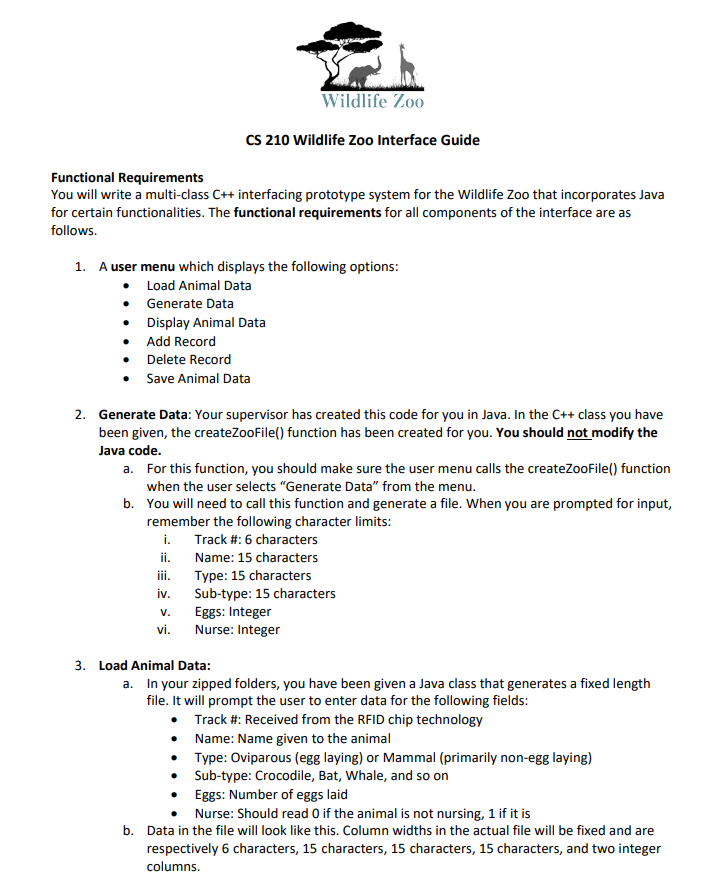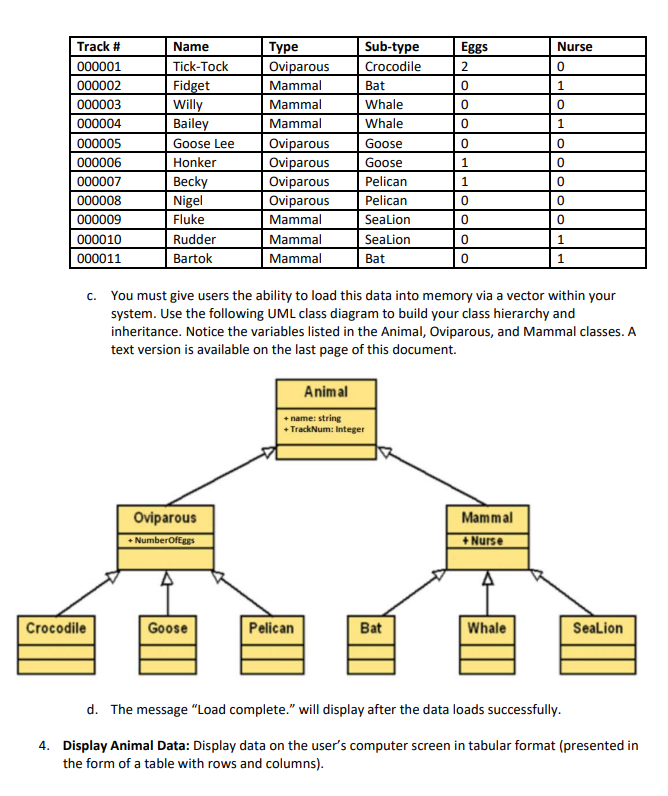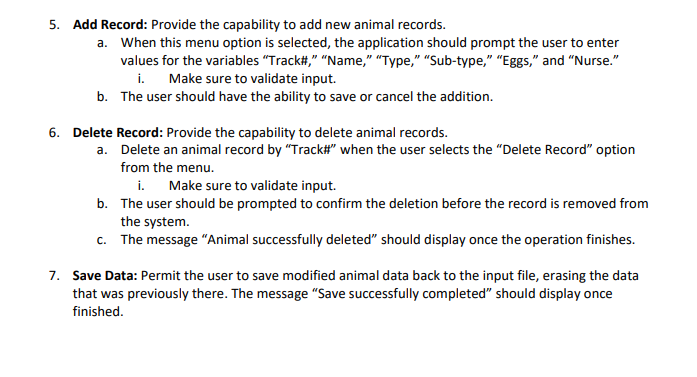Answered step by step
Verified Expert Solution
Question
1 Approved Answer
Did I even do this properly? I can't seem to locate the table or the hierarchy, and overall, I'm just kind of lost. Instructions: Follow
Did I even do this properly? I can't seem to locate the table or the hierarchy, and overall, I'm just kind of lost.
Instructions:
Follow the Wildlife Zoo Interface Guide, located in the Supporting Materials section. These requirements describe the C++ code that you will be creating for the interface, which will include:
-
- User Menu
- Generate a File (this code has been created for you; you will simply need to run this function)
- Loading Data
- Displaying Data
- Adding a Record
- Deleting a Record
- Saving Data
- Remember that you must demonstrate industry standard best practices in all your code to ensure clarity, consistency, and efficiency. This includes:
- Input validation and error handling to anticipate, detect, and respond to run-time and user errors
- Inserting in-line comments to denote your changes and briefly describe the functionality of the code
- Using appropriate variable, parameter, and other naming conventions throughout your code
Interface Guide:



Can someone help to make flowchart or pseudocode, please?
Wildlife Zoo CS 210 Wildlife Zoo Interface Guide Functional Requirements You will write a multi-class C++ interfacing prototype system for the Wildlife Zoo that incorporates Java for certain functionalities. The functional requirements for all components of the interface are as follows. 1. A user menu which displays the following options: Load Animal Data Generate Data Display Animal Data Add Record Delete Record Save Animal Data 2. Generate Data: Your supervisor has created this code for you in Java. In the C++ class you have been given, the createZooFile() function has been created for you. You should not modify the Java code. a. For this function, you should make sure the user menu calls the createZooFile() function when the user selects "Generate Data" from the menu. b. You will need to call this function and generate a file. When you are prompted for input, remember the following character limits: i. Track #: 6 characters ii. Name: 15 characters Type: 15 characters iv. Sub-type: 15 characters Eggs: Integer vi. Nurse: Integer V. 3. Load Animal Data: a. In your zipped folders, you have been given a Java class that generates a fixed length file. It will prompt the user to enter data for the following fields: Track #: Received from the RFID chip technology Name: Name given to the animal Type: Oviparous (egg laying) or Mammal (primarily non-egg laying) Sub-type: Crocodile, Bat, Whale, and so on Eggs: Number of eggs laid Nurse: Should read 0 if the animal is not nursing, 1 if it is b. Data in the file will look like this. Column widths in the actual file will be fixed and are respectively 6 characters, 15 characters, 15 characters, 15 characters, and two integer columns. Nurse Eggs 2 0 0 1 0 0 0 0 1 Track # 000001 000002 000003 000004 000005 000006 000007 000008 000009 000010 000011 Name Tick-Tock Fidget Willy Bailey Goose Lee Honker Becky Nigel Fluke Rudder Bartok Type Oviparous Mammal Mammal Mammal Oviparous Oviparous Oviparous Oviparous Mammal Mammal Mammal Sub-type Crocodile Bat Whale Whale Goose Goose Pelican Pelican SeaLion SeaLion Bat 0 0 1 1 0 0 0 0 0 1 0 0 1 C. You must give users the ability to load this data into memory via a vector within your system. Use the following UML class diagram to build your class hierarchy and inheritance. Notice the variables listed in the Animal, Oviparous, and Mammal classes. A text version is available on the last page of this document. Animal + name: string +TrackNum: Integer Oviparous + NumberOfEggs Mammal + Nurse Crocodile Goose Pelican Bat Whale SeaLion d. The message "Load complete." will display after the data loads successfully. 4. Display Animal Data: Display data on the user's computer screen in tabular format (presented in the form of a table with rows and columns). 5. Add Record: Provide the capability to add new animal records. a. When this menu option is selected, the application should prompt the user to enter values for the variables "Track#," "Name," "Type," "Sub-type," "Eggs," and "Nurse." i. Make sure to validate input. b. The user should have the ability to save or cancel the addition. 6. Delete Record: Provide the capability to delete animal records. a. Delete an animal record by "Track#" when the user selects the "Delete Record" option from the menu. i. Make sure to validate input. b. The user should be prompted to confirm the deletion before the record is removed from the system. C. The message "Animal successfully deleted" should display once the operation finishes. 7. Save Data: Permit the user to save modified animal data back to the input file, erasing the data that was previously there. The message "Save successfully completed" should display once finishedStep by Step Solution
There are 3 Steps involved in it
Step: 1

Get Instant Access to Expert-Tailored Solutions
See step-by-step solutions with expert insights and AI powered tools for academic success
Step: 2

Step: 3

Ace Your Homework with AI
Get the answers you need in no time with our AI-driven, step-by-step assistance
Get Started


